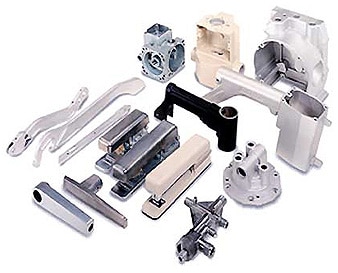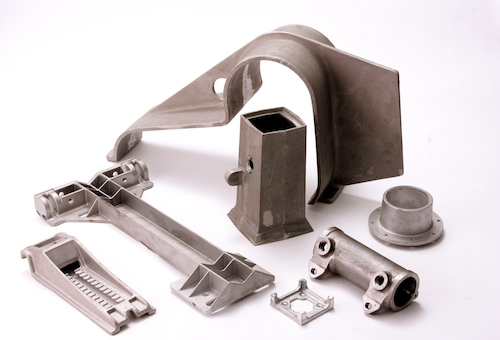All Concerning Aluminum Castings: Understanding Their Function and Significance in Manufacturing
Light weight aluminum castings are integral to modern manufacturing, supplying a blend of light-weight residential properties and durability. They help with complex designs while decreasing setting up costs. Industries such as aerospace and auto regularly utilize these parts for improved efficiency. The production of light weight aluminum castings is not without its challenges. Comprehending the subtleties of this process discloses both the advantages and prospective mistakes. Checking out these factors will supply much deeper understandings into their growing value.
Review of Aluminum Spreading Processes
Light weight aluminum casting procedures play a vital function in manufacturing, using versatility and performance. These processes include pouring liquified aluminum right into molds to develop exact shapes and elements. Different techniques are used, including sand casting, die casting, and financial investment spreading, each distinguished by its approach of mold and mildew creation and the designated application.
Sand spreading makes use of a mixture of sand and binder to form molds, permitting intricate geometries. Die spreading, on the other hand, entails requiring molten light weight aluminum right into steel mold and mildews, leading to high precision and smooth coatings. Investment spreading, typically made use of for intricate styles, entails developing a wax pattern coated with a ceramic shell, which is after that loaded with liquified light weight aluminum.
These casting methods accommodate varied commercial demands, making aluminum a favored material for parts in fields such as vehicle, aerospace, and durable goods. The selection of casting strategy considerably affects the end product's quality and efficiency.
Advantages of Using Light Weight Aluminum Castings
The benefits of using light weight aluminum spreadings in production are many and considerable. To start with, light weight aluminum's light-weight nature contributes to lowered overall item weight, enhancing power efficiency in applications such as automobile and aerospace markets. Furthermore, aluminum castings show excellent deterioration resistance, ensuring long life and resilience in severe settings. The material's thermal and electric conductivity likewise makes it appropriate for numerous applications, including electronic devices and warm exchangers.
On top of that, aluminum spreadings can be generated with complex designs, enabling for more intricate shapes that meet particular functional demands. This adaptability adds to decreased setting up prices and boosted style adaptability. Moreover, the casting procedure itself is reliable, permitting for high-volume production with consistent high quality. Lastly, aluminum is recyclable, making it an eco pleasant alternative in manufacturing. Collectively, these advantages highlight why aluminum spreadings are increasingly preferred across diverse sectors, supplying both efficiency advantages and economic efficiency.
Typical Applications of Aluminum Castings
While numerous products are used in production, aluminum castings stick out due to their wide variety of applications throughout several sectors. These spreadings are commonly used in the vehicle field for engine components, transmission housings, and structural components, adding to lighter vehicles and boosted gas efficiency. In the aerospace industry, aluminum castings are critical for airplane components, where weight decrease is essential for performance and security.
Additionally, the electrical sector uses light weight aluminum castings for real estates and structural components in equipment, benefiting from the material's excellent conductivity. In customer products, aluminum castings can be located in items such as home appliances and sporting equipment, giving durability and a contemporary visual. The construction sector utilizes aluminum castings in building aspects, window frameworks, and fixtures, showcasing their versatility and strength. Generally, light weight aluminum spreadings play an indispensable duty in boosting item efficiency and effectiveness throughout various markets.
Key Production Techniques for Aluminum Castings
The production of light weight aluminum castings depends on various methods, with sand casting and die casting being amongst one of the most famous. Sand spreading involves creating molds from sand, permitting for complex styles and large parts. On the other hand, die casting makes use of high-pressure shot of molten aluminum right into recyclable mold and mildews, offering accuracy and performance for automation.
Sand Casting Refine
Sand spreading stands as one of the most extensively made use of methods for generating aluminum spreadings, thanks to its adaptability and cost-effectiveness. This process entails producing a mold from a combination of sand and a bonding agent, usually clay. When the mold is ready, molten light weight aluminum is put right into it, allowing the steel to fill the dental caries. After cooling, the mold is escaped to reveal the spreading. Sand casting accommodates complex geometries and big parts, making it ideal for different applications. In addition, it enables simple modifications, making it possible for producers to adjust styles quickly. Nevertheless, the surface coating might call for extra machining for precise applications, guaranteeing the end product fulfills high quality criteria.
Pass Away Casting Methods
Pass away casting represents a very reliable technique for producing light weight aluminum spreadings, defined by its ability to provide high accuracy and exceptional surface area coating. This method mainly includes compeling molten light weight aluminum into a mold and mildew under high stress, making sure that intricate forms and fine details are captured properly. There are two major die spreading techniques: hot chamber and cool chamber. Hot chamber die spreading is ideal for alloys with reduced melting factors and allows for faster cycles, while chilly chamber die casting is ideal for high-temperature alloys, requiring separate melting systems. Both techniques improve manufacturing prices and lower product waste, making pass away casting a recommended option in industries such as vehicle and electronic devices, where toughness and dimensional precision are extremely important.
Sustainability in Aluminum Spreading Manufacturing
While the demand for light weight aluminum castings remains to grow, producers are progressively prioritizing sustainability in their production processes. This shift is driven by the need to reduce environmental influence and conserve natural deposits. Several business are taking on reusing initiatives, making use of scrap aluminum, which notably reduces energy consumption and greenhouse gas exhausts compared to key light weight aluminum manufacturing. Additionally, innovations in casting technologies are enabling a lot more effective usage of materials, reducing waste during the manufacturing procedure.
Suppliers are additionally checking out environment-friendly choices to conventional casting techniques, such as 3D printing and advanced mold modern technologies, which assist enhance resource usage. Aluminum Foundry. Furthermore, implementing sustainable methods in supply chain monitoring assurances that basic materials are sourced responsibly. Therefore, the click resources light weight aluminum spreading market is making strides towards an extra sustainable future, straightening with worldwide environmental objectives while fulfilling the increasing demand for high-performance aluminum products
Challenges and Considerations in Light Weight Aluminum Casting
Aluminum casting presents various difficulties that producers need to browse to assure product integrity. Design intricacy can make complex the spreading process, resulting in prospective problems and boosted production time. In addition, keeping rigorous quality assurance standards is important to fulfill the needs of accuracy and dependability in completed parts.

Layout Complexity Issues
Creating components for light weight aluminum spreading presents numerous complexities that designers must browse to attain excellent outcomes. One significant obstacle is the need for precise geometry; complex designs can cause difficulties in mold and mildew creation and raised danger of issues. In addition, thermal properties of aluminum demand careful factor to consider of cooling down prices, as uneven air conditioning can cause warping. Wall surface thickness variations likewise position a challenge, as they can influence flow features and architectural honesty. Designers need to stabilize design aesthetics with manufacturability, making certain that attributes such as fillets and ribs are optimized for toughness without complicating the casting process. Lastly, factors to consider regarding draft angles are necessary to help with mold release, additional complicating the style procedure. These factors collectively underscore the ins and outs associated with aluminum spreading layout.
Quality Assurance Difficulties
Accomplishing high-grade aluminum spreadings involves steering a series of high quality control obstacles that can significantly affect the end product. Initially, variants in raw product structure can bring about variances in casting buildings, making it important to ensure material quality. Second, the casting procedure itself is at risk to defects, such as porosity and shrinkage, which can jeopardize architectural integrity. Furthermore, temperature control during melting and putting is crucial; fluctuations can lead to unequal solidification, affecting dimensional precision. In addition, complete inspection techniques, including non-destructive testing, need to be employed to identify issues early. Lastly, preserving stringent process documentation and adherence to market criteria is important for traceability and quality guarantee, highlighting the intricate balance needed to produce dependable light weight aluminum spreadings in manufacturing.
Future Fads in Aluminum Spreading Technology
As suppliers seek to improve efficiency and sustainability, innovations in light weight aluminum spreading technology are arising to meet these demands. One significant pattern is the combination of automation and expert system, which simplify manufacturing procedures and enhance accuracy in casting procedures. These improvements reduce human error and enhance resource use, inevitably causing set you back decreases.
In addition, the adoption of innovative products and alloys is reshaping the landscape. New solutions boost efficiency attributes, such discover this as deterioration resistance and lightweight buildings, making aluminum spreadings a lot more flexible across various industries.
Additionally, lasting practices are obtaining grip, with a concentrate on recycling and minimizing waste. Methods such as 3D printing are also being explored to create complicated geometries that were formerly unattainable
Often Asked Inquiries

How Do Aluminum Castings Compare to Other Products?
Light weight aluminum castings offer advantages such as light-weight, corrosion resistance, and outstanding thermal conductivity contrasted to other materials. They are frequently chosen for applications requiring sturdiness and her response effectiveness, especially in vehicle and aerospace sectors.
What Is the Lifespan of Aluminum Castings?
The life-span of light weight aluminum spreadings generally varies from 10 to 50 years, depending upon ecological problems, use, and maintenance. Their deterioration resistance and durability contribute visibly to their long-lasting efficiency in different applications.
Can Aluminum Castings Be Reused?
Yes, light weight aluminum castings can be recycled. The recycling procedure is efficient, permitting the recuperation of aluminum without considerable loss of quality, making it a lasting option in manufacturing and decreasing ecological impact.
What Precaution Are Needed Throughout Light Weight Aluminum Spreading?
During aluminum casting, necessary safety and security actions include putting on suitable personal protective devices, making sure proper ventilation, maintaining tools, using fire-resistant materials, and executing risk-free managing protocols for molten steel to protect against injuries and crashes.
How Do Temperature Adjustments Impact Light Weight Aluminum Castings?
Temperature level adjustments considerably impact light weight aluminum castings by influencing fluidness, solidification rates, and mechanical residential properties. Rapid air conditioning can cause enhanced brittleness, while gradual air conditioning promotes much better architectural stability and minimizes the threat of defects.
Pass away spreading, on the other hand, entails compeling liquified aluminum into metal molds, resulting in high accuracy and smooth finishes. The manufacturing of light weight aluminum castings counts on numerous methods, with sand spreading and pass away spreading being among the most prominent. Sand casting stands as one of the most extensively utilized approaches for generating aluminum castings, many thanks to its flexibility and cost-effectiveness. Die casting stands for an extremely effective approach for producing aluminum spreadings, characterized by its capability to deliver high accuracy and outstanding surface area finish. While the need for aluminum castings proceeds to expand, manufacturers are significantly focusing on sustainability in their manufacturing procedures.